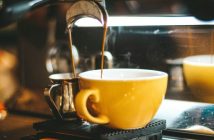
In the world of an IB diploma student, coffee is the antidote to turning a frown upside-down. Many would shrug and say, “coffee is coffee”, without considering where it all came from—as long as they can get their morning fix.But, how do we make our coffee? There are three ways of making coffee as we know it—through filtering, powder or espresso. Read on as we compare the three methods.
Filtered coffee
Filtered coffee can be considered a very economical version of the popular beverage. Grounded coffee beans are placed in a filter before water is allowed to drip through. The finished product is then collected at the bottom as black coffee.If you have ever ordered a “Today’s Brew” in a cafe, this is essentially how your coffee is made. The ratio of grounded bean mass to liquid coffee is fully maximised, ensuring a high concentration of coffee. However, when observed from under a microscope, filtered coffee has large and coarse caffeine particles, meaning that caffeine extraction is not completely thorough.
Powdered Coffee
A slightly more expensive variant of coffee is powdered coffee. This is the coffee we buy at supermarkets in jars or sachets. It is industrially produced by boiling filtered coffee for days until all water content is removed, leaving behind anhydrous powder. When boiling water is added to the coffee again, it essentially shares the same properties as filtered coffee. Powdered coffee is easy to store and prepare, making it ideal for the IB student, since “ain’t nobody got time” to wait for coffee filtration. Some companies take powdered coffee one step further by adding powdered milk and sugar to it before sealing up the sachets, marketing the product as “three in one” for the convenience it brings.

The Espresso
The best way of making coffee is through an espresso machine. High pressure boiling water gushes through grounded beans, producing very concentrated coffee.Espresso was traditionally hand-pressed, but today,mechanised air pumps are used to drive boiling water through the beans. An espresso can be said to be a template for coffee since many variants of the beverage were derived from the espresso. You can add a specific amount of water to an espresso for an Americano,a different amount of water for a Latte,or a dash of milk to make it a Macchiato. This is how most cafes make their coffee, including those in Beijing international schools.
Espresso machines are rather bulky and expensive, making it impractical for the home user. However, since the turn of the century a new type of espresso machine has emerged—the Nespresso machine. This machine is programmed to make the perfect espresso from pre-grounded beans packaged into pod-like capsules.There are many blends to choose from,including caramel, chocolate, citrus and even decaf. An increasing amount of people own Nespresso machines for convenient access to quality coffee.
Coffee is coffee
At the end of the day, regardless of how coffee is made, it is here in the form of a warm beverage to keep us awake. These three methods of making coffee have their different merits, from price to convenience to quality.Despite these differences, the writer is an avid coffee enthusiast and loves all forms of coffee equally.
This article originally appeared in the November-December,2013 issue of UNIT-E. It was written by Russell Ng, a student at the Yew Chung International School of Beijing.
About UNIT-E
UNIT-E was founded in the spring of 2010 with the aim of establishing a non-profit, student-run magazine for international students in Beijing. Staffed by current students from a range of international schools, the magazine provides an amalgam of cultural tidbits, fragments of Beijing student life, and a broad spectrum of unique perspectives from a diverse group of young adults.
Photos courtesy of trophygeek and bortescristian (Flickr)



